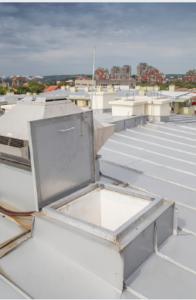For residential buildings, often apartments, roof access hatches provide a smartly styled way to grant access to roof terraces. They also flood rooms with natural light and can be combined with a service stair.
 They are a safer alternative to exterior wall ladders that anyone can access, causing security risks and damage to rooftop installations. However, they still require adherence to fall protection regulations.
They are a safer alternative to exterior wall ladders that anyone can access, causing security risks and damage to rooftop installations. However, they still require adherence to fall protection regulations.
Residential buildings
Roof access hatches solutions provide easy and safe access to the roof of a home. They eliminate the need for a ladder and make it easier for maintenance workers to inspect or repair a home’s roof. It can help reduce the risk of fires. The installation of a roof access hatch also improves accessibility during an emergency, which could save lives. Ladders can become unstable or tip over, causing injuries or even deaths. Roof hatches are built with insulating materials that help prevent fires from spreading.
Residential roof access hatches are easy to install and can be fitted on flat or slightly sloping roofs. They can be opened and closed manually or using a push rod, making them accessible. Depending on the building type, they are available in several designs and sizes. They are typically made of galvanized steel or aluminium and feature fully welded corners, insulation in the cover and curb, and a full perimeter gasket for weatherproofing. They are often rated to protect against dust, water, and ice. Some are even rated for fire resistance, which increases safety and security.
A roof hatch’s design can vary from manufacturer to manufacturer, but they should all offer the same features to ensure safety and functionality. These features include an automatic hold-open arm, safety latches, and interior and exterior padlock hasps. For high-security applications, several custom security options may be available, such as keyed cylinder locks and contact switches that can be wired into the building’s alarm system control panel. For more information about the roof access hatches solutions, click here.
Some roof hatches are designed with a polycarbonate dome cover to provide the added benefit of a skylight. It can increase natural lighting in a facility and create a more pleasant work environment while decreasing energy costs. Many hatches are also equipped with louvres to provide ventilation and simplify operation. Hatches are also available in various finishes, including anodized aluminium and paint finishes such as Kynar, Tnemec, and powder coating.
Commercial buildings
Roof access hatches are used in non-residential buildings to provide safe and convenient access to rooftop areas for maintenance work. These hatches can reduce the need for workers to climb ladders or use other dangerous climbing methods. In addition, they can improve emergency access during evacuations. They can also help maintain building energy efficiency by reducing the amount of air lost through traditional roof vents.
A number of factors must be considered when selecting a roof access hatch for a commercial building. The type and size of the structure generally determine the method of egress, which in turn dictates roof hatch size. For example, a manufacturing facility typically uses an interior ladder, whereas offices or schools may have a ship stair or full-size staircase. For equipment access, larger roof hatch sizes can be fitted with a service stair or crane to allow for the installation or removal of large equipment from a building.
Hatches designed for personnel access are usually supplied with interior and exterior padlock hasps to control access to the opening. They can also have a contact switch wired into a building’s alarm system control panel. Some hatches are designed to open and close with an electric motor or winch for added convenience and security.
Because workers are usually raising a hatch upward from inside the building while standing on a ladder or stairs, they need to be able to easily and quickly operate the door. Therefore, the design professional must specify a hatch with uniform lift assistance that minimizes the effort required for operation. Some manufacturers also offer a hold-open arm to keep the cover from slamming shut on a worker as they enter or exit. This feature is essential when the hatch must be left unattended for extended periods. Other considerations include corrosion resistance and energy efficiency. The hatch should be insulated and fully weatherproof to prevent heat or cold from escaping through the open roof area. For more information about the roof access hatches solutions, click here.
